To ancestral futures
Télécharger la VF du catalogue de l’exposition Aux Futurs ancestraux
The global games market is still dominated by Europe, the United States and Japan.The exhibition “Aux futurs ancestraux” adopts a decolonial perspective on art and games in order to echo works conceived on the periphery of this global and globalizing culture. “Aux futurs ancestraux” immerses us in other types of representations, cities, landscapes, narratives and cosmogonies, conceived and expressed in other languages, and seeks to decolonize our imaginary through the co-construction of narratives born of the encounter between oral tradition, endogenous knowledge and the virtual universes of video games.
This necessary dialogue between these different modes of knowledge requires a paradigm shift. Science and human thought are no longer the only sources of knowledge; it is now possible to think of knowledge “beyond the human” (Eduardo Kohn). “This implies that nature thinks, that animals think, and that non-humans can teach us techniques and knowledge, by changing our perspective. (Viveiro de Castro).
Between photo installations, drawing, performance, video installations, immersive, interactive and video game, an exhibition that invites us to reconnect with what connects us to our ancestral futures: the living.
:quality(85)/cloudfront-us-east-1.images.arcpublishing.com/infobae/UQ76YOQIIJGIHCDUTHMLAQDU3M.png)
Artists
High in the Sky and Beneath the Stars, Laura Palavecino, (AR), interactive installation
Laidaxai, Daniela Fernandez, (AR) video game
Paramo, Eulalia De Valdenebro Cajiao, (CO), Installation drawings video
Water Divinity, Henri Tauliaut (Martinique), Video game
Atuel, Matajuegos, (ARG), Video game
Coca para comer, Aniara Rodado, (CO), Installation, Performance
Epiculus Garden, Tania Fraga, (BR), Video Installation
Infinitree, Mbaye Camara (SN) & Isabelle Arvers (FR), Machinima
Isabelle Arvers is a French artist and curator whose research focuses on the interaction between art and video games. She studies the artistic, ethical and critical implications of digital gaming, and explores the creative potential of video game piracy. As a curator, she focuses on video games as a medium for artists. In 2019, she is touring the world of art and games in non-Western countries to promote notions of gender and sexuality diversity, as well as geographic origin, focusing on queer, feminist and decolonial practices. Website: www.isabellearvers.com
To ancestral futures
From ancestral knowledge to digital
26th of January – 12 of March 2023
Exhibit space of Guyancourt
Opening on the 25th of January
Atuel a video game by Matajuegos
Matajuegos is an Argentine independent game cooperative, creating Latin American games that open up social, political and cultural perspectives. Formed in 2015 by Santiago Franzani and Pablo F. Quarta, the group explores issues of labor, gender, art, politics and regional identity.
A documentary video game dealing with the climate crisis, Atuel was born as a complement to the documentary film of the same name, which focuses on the realities of contemporary life in the Atuel River Valley in Argentina, in the context of the water crisis caused by climate change. Throughout the film and game, we hear the voices of local geologists, historians, biologists, lawyers and artisans, who testify to their knowledge and experiences of this region. In this way, Atuel evokes the natural and cultural identity of the region, providing insight into its past, present and future, while connecting its internal conflicts with the global issues of climate change and landscape preservation.
Although the topography of the game Atuel is inspired by the real landscape of the river and its region, it differs from the film by its dreamlike and surreal qualities. During a game, the players are invited to incarnate the Atuel river. Through this metamorphosis, the game allows to consider non-human perspectives – in particular those specific to the territory’s fauna -, but also to (re)discover the intimate relationship that links human societies to rivers. In this sense, the Atuel game highlights the interconnectedness of the elements of an ecosystem that extends from the river, while showing how climate change is affecting and vulnerabilizing the relationships that human societies have with their place.
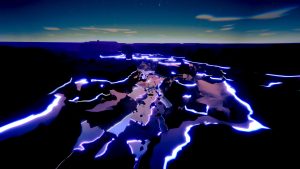
View of Atuel, Matajuegos, Argentina, video game, 2022
Laidaxai, a video game by Daniela Fernandez
Daniela Fernandez is an Argentinian illustrator and designer of images and sounds. A member of the group of dissident women in the Argentinian video game sector since 2018, she develops video games from a decolonial, feminist and non-violent perspective.
Daniela Fernandez works from stories told in her family with a diverse cultural mix (Spanish, French, Guarani and Argentinian). As a designer, she tries to tell stories – especially those of indigenous peoples – as her ancestors did, but through video games.
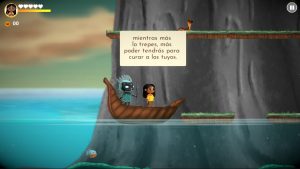
View of Laidaxai, Daniela Fernandez, Argentina, video game, 2021
In 2020, she developed and directed, Laidaxai, The Black Tree, a video game inspired by the story of the Primordial Tree of the Toba-Chaqueno people of Qom, with the help of community members from the Chaco region of northern Argentina. In the game, the protagonist Laidaxai must save her community from a strange disease by completing the ordeal of the Black Tree.
High in the sky and beneath the stars, an immersive installation by Laura Palavecino
Laura Palavecino is a professor-researcher in the field of game art and an image and sound designer. Her work brings together traditional art and technology, with the aim of provoking an emotional encounter with nature through different fields of knowledge: science, ancestral stories and the humanities. Laura Palavecino, an artist from the suburbs of Buenos Aires, Argentina, describes nature as a place both inside and outside of herself. In her work, she seeks to question the boundaries between play, art, design and narrative, through projects that make visible the control of interfaces, information, contemplation and visual poetry.
High in the Sky and Beneath the Stars is a work composed of a physical installation (a space materialized by a “magic circle” that we are invited to enter) and an immersive virtual space. Conceived as a posthuman landscape, the work brings together the four elements symbolized: water, earth, air and fire.
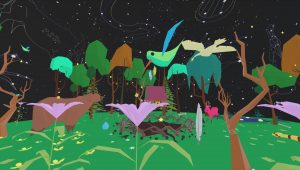
View of High in the Sky and beneath the Stars, Laura Palavecino, Argentina, immersive online space, interactive installation, 2021
In the virtual landscape, several animals stand out against the background of a starry sky: they are cardinal points that allow us to orient ourselves in the cosmos. While these species were chosen for their importance in the environment as well as in the ancestral stories told by the native people of Argentina, they are also indicators of the health of Latin American ecosystems currently threatened by deforestation, pollution, urban sprawl, monoculture and poaching. They are also a sacred value in some native cultures, notably among the Quechua, Guarani and Toba populations.
High in the Sky and Beneath the Stars connects us with the Cosmos and life on Earth, while embodying the barrier that separates us from nature as thought by Modernity.
Water Divinity, a game installation by Henri Tauliaut
Artist and researcher, Henri Tauliaut is interested in the relationship between art and science, particularly in the fields of interactive art and bio-art. He exhibits and performs in the Caribbean, South and North America, France, Senegal and China.
Henri Tauliaut considers that it is vital for the development of Caribbean cultures that the people who come from them create their own images, representations and current myths. To anchor themselves, they need ancestrality, that is to say, to recognize their dead, ancestors and deities, in order to give them back a culture that is animist or totemistic:
“In order to center ourselves, we need founding myths with which we can really identify. In order to project ourselves and propose imaginaries where we are at the center, we need Afro-futurism, Native-futurism or any other new form allowing us to offer our youth positive and utopian visions of our future.
Finally, to take care of our communities, our people, we need to reconnect with ancient therapeutic, religious and metaphysical practices by giving them a current form integrating contemporary technologies and thus creating spiritual practices such as techno-shamanism or techno-voodoo.”

The fourth and final installation in the Interfaces video game series, Water Divinity Game consists of an interactive and immersive video game and installation created between 2020 and 2022. The objective of the game is to allow viewers to encounter Afro-Caribbean water deities.
In this work, players enter the heart of the Haitian pantheon and meet various Afro-Caribbean aquatic deities from the Haitian voodoo pantheon. In the second level, which takes place underwater, players are led on a quest to uncover the hidden secrets of the Veve in space. They will find the ship Immamou, the ship of the ocean god Agwe to take them there.
View of Water Divinity, Henri Tauliaut, Martinique, video game, interactive installation, 2022
Frailejonmetría Comparada Ech 1:1, Mapa De Relaciones Táctiles Ech 1:1 by Eulalia de Valdenebro Cajeao
Popayán Visual artist (Colombia) born in 1978, Eulalia de Valdenebro Cajeo is a botanical illustrator. She is a research professor at the Universidad Nacional de Colombia, and works from the link established with the vegetal beings. Her works are part of the research-creation of her doctoral thesis in Art and Ecosophy (Paris 8 University). All of this work was carried out in the Páramo, a typical macrodiverse ecosystem of the high mountains of the intertropical Andes, located near Bogotá, at an altitude of 3000 meters.
Eulalia De valdenebro Cajeo questions her role as an artist in the face of what the philosopher Isabelle Stengers calls the “intrusion of Gaia”. This expression conveys the idea that the Earth-system dominated by modern societies reminds us (in particular through climate change) in a feedback loop making us more and more dependent on what the moderns have caused. For the artist, dealing with this intrusion involves re-evaluating and re-imagining the foundations of our thinking, our ways of doing, knowing, being and relating to natural beings and forces.

In Comparative Frailejonmetry and the Map of Tactile Relationships, the artist worked with frailejones (Espeletia grandiflora, family Asteraceae), emblematic plants of the Colombian páramos, which have the aesthetic power to resemble human beings, while critically seizing botanical illustration and herbarium specimens.
In these artistic practices, she uses her body as a unit of measurement and displaces her condition as a human being (subject) in relation to the plant (object). By using the same methods of study for her body as for the plant, she is in effect on the same plane of representation. This idea is also found in the series Corpsperméables, through work done in situ.
Frailejonmetría Comparada Ech 1:1, Mapa De Relaciones Táctiles Ech 1:1, Eulalia de Valdenebro Cajeo, Colombia, drawing, 2020
Epiculus Garden, a generative video installation by Tania Fraga
Tania Fraga is an architect, computer artist and researcher using brain-computer interfaces within immersive interactive environments. She creates virtual reality customized software for site specific installations looking for symbiosis among humans and computers. In her work, she seeks to create virtual and material realities through the integration of art, science and technology. Numbers, which she considers as sensitive expressions of a sublime and transcendental dream world, have an important place in her work.
Originally, Epicurus Garden was an interactive, non-repetitive video installation based on mathematical data resulting from the analysis of the viewer’s brain activity through an EEG headset (a device that measures the electrical activity of the brain, electroencephalogram). The behaviors of the plants present in the video were thus affected by the mathematical interpretation of the viewer’s emotions, thus conferring on the virtual agents a form of autonomy. In this way, Tania Fraga seeks to create what she calls an “exo-endogenous” interaction, that is to say a form of symbiosis where human and virtual behaviors respond to each other.
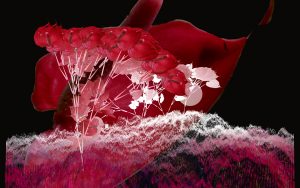
View of Epicurus’ Garden, Tania Fraga, Brazil, generative video installation, 2017
In the exhibition Aux Futurs Ancestraux, the video presented is no longer directly connected to a human brain through an EEG headset. Programmed in Java, the behaviors of the plants in Epicurus’ Garden are nevertheless the result of the artist’s attempt to compose a world similar, albeit simplified, to nature and life: it is the sound and visual expression of a fluid mathematical universe.
Infinitree, painting and machinima installation by Mbaye Camara and Isabelle Arvers
Isabelle Arvers and Mbaye Camara meet in Dakar in 2021. In 2022, they begin to elaborate a documentary project around the supernatural and medicinal powers of trees, to mix their practices related to video games, painting, plant installations and 3D film making.
The work Infinitree initiates a dialogue between ancestral and scientific knowledge against the background of communication between trees, between humans and non-humans, in an installation that mixes paintings of fantastic gardens, installation of gourds, and machinima, a film created from fragments of virtual universes, in this case from a video game.
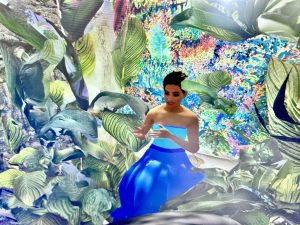
View of Infinitree, Mbaye Camara, Isabelle Arvers, Machinima, acrylic paint, callebasses, 2023
In Wolof, Garab means tree and medicine. The tree feeds us, heals us, shelters us and protects us. Present on this earth for thousands of years, some species are threatened by massive urbanization, overconsumption and overexploitation of economies. Pollution and global warming are the consequences…
The Adansonia, commonly called baobab, participates in all aspects of life of living beings whether social, political, cultural or economic. Today, it is threatened with extinction. The one that has the power to build us can also make us fall… Out of the nine species of Baobabs that exist, three are currently threatened with extinction.
Alerted by this phenomenon which has been accelerating for ten years, Isabelle Arvers and Mbaye Camara propose a journey to the heart of the baobabs, to remind us of the importance of communicating with the trees, of returning to balanced relationships and of remaining attentive to this knowledge and these practices. The material that serves as a basis for the narrative are interviews with artists conducted by Isabelle Arvers in Senegal in 2021/22, around the tree and its supernatural powers. Isabelle Arvers interviewed the Congolese artist Gael Manandou and the Senegalese artist Jah Gal Doulcy. These artists have been initiated to the knowledge of trees, their stories serve as the basic material for a new kind of documentary, between video, animation and machinima.
Coca para comer, a video installation by Aniara Rodado
Choreographer, artist and researcher, Aniara Rodado explores witchcraft and interspecific relationships from the plant world, from a trans-feminist perspective. Her practice questions the current context of ecological crisis and techno-scientific fetishization. The tendency to standardize the various forms of life, at all scales, affects bodies as well as alliances and knowledge.
In the video installation Coca para comer, Aniara Rodado makes the coca leaf “travel” and “speak”. Considered sacred, the coca leaf has been used in the Andean region for 8000 years for its cultural, ritual, nutritional and medicinal functions.
The coca is not the drug cartels, nor the hyperproductive capitalism. It is not deforestation and glyphosate sprayed from airplanes onto the dead soil and contaminated rivers of Colombia, nor is it the war on drugs, nor is it the last gasp of the people enslaved for centuries in the silver mines of Potosi. It has never been anything but the luxury of the Inca elites.
Through this work, Aniara Rodado tries to alert us to the danger of demonizing plants that heal, nourish or “drug”, and with which entire peoples have collectively built epistemologies, ontologies and ecologies.
For her, the process of turning a sacred plant into an illicit commodity amounts to committing epistemicides and, therefore, to taking part in the witch hunt, which aims to break the links between communities, their knowledge and their lands.

View of Coca para comer, Aniara Rodado, Colombia, video installation, leaf carpet, 2023
—————————————————————————————————
Des savoirs ancestraux au numérique
Le marché mondial des jeux est encore dominé par l’Europe, les États-Unis et le Japon.
L’exposition « Aux futurs ancestraux » adopte une perspective décoloniale sur l’art et les jeux afin de se faire écho d’œuvres conçues à la périphérie de cette culture globale et globalisante .`Aux futurs ancestraux nous immerge dans d’autres types de représentations, villes, paysages, récits et cosmogonies, conçus et exprimés dans d’autres langues, et cherche à décoloniser notre imaginaire par la co-construction de récits nés de la rencontre entre tradition orale, savoirs endogènes et univers virtuels des jeux vidéo.
Ce dialogue nécessaire entre ces différents modes de connaissance, nécessite un changement de paradigme. La science et la pensée humaine ne sont plus les seules sources de connaissances ; il est désormais possible de penser à des connaissances “au-delà de l’humain” (Eduardo Kohn). ” Cela implique que la nature pense, que les animaux pensent, et que les non-humains peuvent nous enseigner des techniques et des connaissances, en changeant de perspective. (Viveiro de Castro).
Entre installations photo, dessin, performance, installations vidéo, immersives, interactives et jeu vidéo, une exposition qui nous invite à nous reconnecter à ce qui nous relie à nos futurs ancestraux : le vivant.
Artistes
High in the Sky and Beneath the Stars, Laura Palavecino, (AR), installation interactive
Laidaxai, Daniela Fernandez, (AR) jeu vidéo
Paramo, Eulalia De Valdenebro Cajiao, (CO), Installation Photos et Dessins
Water Divinity, Henri Tauliaut (Martinique), Jeu Vidéo
Atuel, Matajuegos, (ARG), Jeu Vidéo
Coca para comer, Aniara Rodado, (CO), Installation, Performance
Epiculus Garden, Tania Fraga, (BR), Installation Vidéo
Infinitree, Mbaye Camara (SN) & Isabelle Arvers (FR), Machinima
Commissariat : Isabelle Arvers
ACTIVITÉS AUTOUR DE L’EXPO :
Mercredi 25 janvier à 18 h 30 :
Performance d’un artiste de l’exposition lors du vernissage + Hors d’œuvre avec la maison de quartier Théodore-Monod.
Samedi 28 janvier à 11 h :
Table-ronde autour de la décolonisation du numérique avec Isabelle Arvers et une artiste de l’exposition.
Mercredi 1er février à 14 h 30 :
Rendez-vous pour les enseignants.
Mercredi 8 mars de 14 h 30 à 16 h 30 :
Atelier montage vidéo avec son téléphone portable.
Inscriptions auprès du service Arts visuels
AVEC LE CENTRE SOCIAL DU PONT DU ROUTOIR,
Samedi 28 janvier à partir de 14 h 30 :
Atelier de création d’une exposition virtuelle à partir des œuvres de l’artothèque avec Isabelle Arvers.
Inscriptions auprès du Centre social du Pont du Routoir.
À LA MAISON DE QUARTIER THÉODORE-MONOD
Courant février 2023 :
Atelier Hybridation
Tarifs et réservations au 01 30 44 38 54
VERNISSAGE :
mercredi 25 janvier à 18 h 30
En partenariat avec le Musée de la ville,
la médiathèque Jean-Rousselot.

Comments are closed.